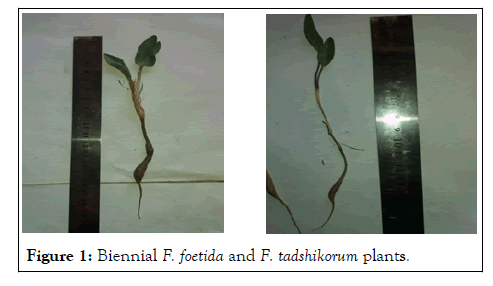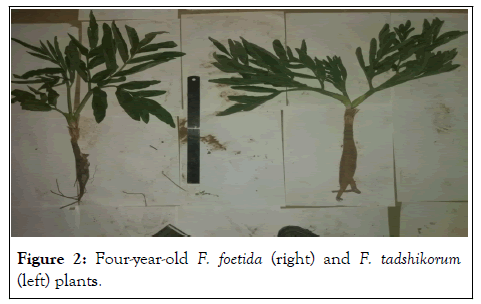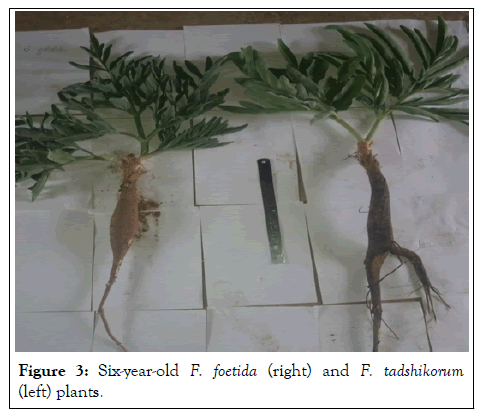Journal of Plant Biochemistry & Physiology
Open Access
ISSN: 2329-9029
+44 1478 350008
ISSN: 2329-9029
+44 1478 350008
Short Communication - (2022)Volume 10, Issue 2
Ferula foetida and Ferula tadshikorum are perennial monocarpic plants whose resin reserves are declining sharply as a result of unplanned, ruthless use. They bloom once every 7-25 years and end their lives. The ontogenesis of the major life cycle of Ferula tadshikorum and F. foetida is divided into 3, young periods: Embryonic (se-seeds), virginil (r-grass, j-juvenile, im-immature, v-virginil), manifested in generative periods, this only the juvenile phase is given in the article.
For 2015-2020 in Arnasay district of Jizzakh region in plantations in dry lands in the juvenile phase 2-3-4-5-6 years F. tadshikorum and F. foetida were observed and biomorphological features of the leaves and roots of the link differed from each other and pictures of 2 to 6 years were given.
Leaf; Plantation; Plant; Ferula foetida; F. tadshikorum; Root; Bud; Resin; Soil
The representatives of the family Apiaceae L. have a special place among medicinal plants in our country. Representatives of the Ferula L. family are important in this family, and there are about 200 species in the world. There are 114 species in Central Asia and about 50 in Uzbekistan [1].
In recent years, plant resin in the Republic is obtained mainly from the roots of F. tadshikorum, F. foetida, which belongs to the family Ferula L. Every year, more than 400 tons of resin raw materials are exported in our country, and more than 150 tons in Tajikistan [2]. As a result of unplanned, ruthless use of plants, its natural resources are drastically depleted. This situation has a negative impact on the population status of plants and the ecology of Ferula. Because resin makers have to get resin from the root from the plant’s 5-6 year vegetation, they are also destroying the plant’s 2-3 year old plants in order to make a good profit.
Field experiments were carried out in the soil conditions of Jizzakh and Kashkadarya regions according to the above options. The main soils in which the F. foetida is grown are located in the gray zone. Mainly typical gray and gray-meadow soils are the object of study.
Perennial monocarp plant in F. foetida. In Uzbekistan, it is found in various groups of plants in deserts and hills, and is distributed in the Kyzylkum desert, Mirzachul, Karnabchol, Samarkand, Jizzakh, Bukhara, Kashkadarya, Surkhandarya regions and the Republic of Karakalpakstan [3].
In F. foetida, the plant reaches a height of 1.0-1.5 m. The root is strong, thick, reaching a depth of 1.5 meters into the soil. The main part of the root reaches a depth of 0.5 m and forms a tuber, which is cylindrical, barrel-shaped or ovoid.
In F. foetida, the stem of the plant is erect, slightly hollow inside, branched from the top, often forming a single generative branch, flowering and fertilizing once in 7-9 (23) years.
The juvenile phase is associated with the transition to an early immature and generative state, its morphological changes of grasses and roots, and includes the development of fractures from the second to the sixth year. Plants of F. tadshikorum and F. foetida during this period all the annual members develop in early spring and begin to form leaves and root nodules. During this period, biennial plants in both species have 2 small curly leaves, from the third to the sixth year, initially 2-3 small curly leaves and the rest of the previous year, 2-3 leaf remnants located on the root, in these years also curly leaves. They formed in early February and dries up in late March. It protects the bud from cold, uncomfortable conditions during growth. During the six years, the number of leaves on the plant starts at 2-3, and they grow bigger every year (Figure 1) [4].

Figure 1: Biennial F. foetida and F. tadshikorum plants.
The growth dynamics of the F. tadshikorum and F. foetida tubers of the juvenile phase are given in Table 1 below.The leaves of both species are morphologically different. The leaf blade of F. tadshikorum is ribbon-shaped, while that of F. foetida is ovate. Each leaf is divided 3-4 times, in both species the first leaf appears first, the second leaf after 10-15 days, but the second leaf is longer and wider than the first leaf, each divided leaf of F. tadshikorum is large and bright green in color. From the second year, the hairs under the leaves of F. foetida begin to be clearly visible, but in F. tadshikorum the hairs are unknown. In addition, the color of the leaf band of F. tadshikorum differs from that of F. foetida by the color of the ink. The size and number of leaf plates of both species are given (Figure 2) [5].
| Age | Days (2018-2019-2020 annual) | |||||
|---|---|---|---|---|---|---|
| 0.5-10.02 | 15-20.02 | 20-28.01 | 10-15.03 | 25-30.03 | 10-15.04 | |
| F. tadshikorum | ||||||
| 2-annual | 3.5 ± 0,08 | 9 ± 0.33 | 15 ± 0.63 | 20.5 ± 0.57 | 22.5 ± 0.90 | 25 ± 1.05 |
| 3-annual | 4 ± 0,10 | 8 ± 0.20 | 12 ± 0.45 | 21. 5 ± 0.81 | 21.5 ± 1.07 | 20.5 ± 0.96 |
| 4-annual | 6 ± 0.15 | 9.5 ± 0.33 | 13.5 ± 0.39 | 18.5 ± 0.77 | 36 ± 1.37 | 40.5 ± 1.86 |
| 5-annual | 5 ± 0.17 | 10 ± 0.26 | 18.5 ± 0.48 | 29 ± 1.04 | 42.5 ± 1.99 | 47.5 ± 1.80 |
| 6-annual | 7 ± 0.09 | 11.5 ± 0.32 | 19.5 ± 0.54 | 27 ± 1.02 | 39 ± 1.40 | 49.5 ± 2.22 |
| F. foetida | ||||||
| 2-annual | 4 ± 0.11 | 7 ± 0.32 | 13 ± 0.58 | 15. 5 ± 0.57 | 17.5 ± 0.80 | 30 ± 1.35 |
| 3-annual | 7 ± 0.23 | 5 ± 0. 21 | 10 ± 0.44 | 17.5 ± 0.61 | 22.5 ± 0.85 | 26 ± 1.01 |
| 4-annual | 5 ± 0.19 | 7.5 ± 0.33 | 9 ± 0.22 | 11 ± 0,49 | 22.5 ± 0.94 | 31 ± 1.17 |
| 5-annual | 5 ± 0.21 | 8 ± 0.40 | 14 ± 0.53 | 21.5 ± 0.73 | 28 ± 42 | 39.5 ± 1.66 |
| 6-annual | 4 ± 0.17 | 7 ± 0.26 | 17.5 ± 0.73 | 25 ± 1.05 | 30 ± 37 | 45 ± 1.89 |
Table 1: Dynamics of growth of bush leaves in the juvenile phase Ferula tadshikorum and Ferula foetida (n=350).

Figure 2: Four-year-old F. foetida (right) and F. tadshikorum (left) plants.
In the juvenile phase, the 2-6-year-old F. tadshikorum and F. foetida had long 2018 vegetation, but their growth sprouted later than in 2019-2020. The main reason for this is the large amount of precipitation and the relatively low temperature. The higher the temperature, the more likely it is that they will see the leaves and go into a dormant state. During this period, the leaf blade of F. tadshikorum retains a band-like shape, while in F. foetida the niki retains an ovoid shape. Both species produce mostly 2-3 to sometimes 4 leaves. The leaf plates of F. tadshikorum are long, large, each leaf is divided into 7-35 times, the leaf segments are 10-15 cm long and 5-8 cm wide, while the leaf of F. foetida is divided into 10-45 segments, the length of the segments 5-12 cm long, 3-6 cm wide. In F. foetida the leaf plates are more divided than in F. tadshikorum, but differ in height and width relative to it (Figure 3) [6] .

Figure 3: Six-year-old F. foetida (right) and F. tadshikorum (left) plants.
From the second to the sixth year in F. foetida and F. tadshikorum root nodules increase in thickness and length. Aspects of the morphological features of the roots of the two species begin to differ from each other. The morphological classification of the roots of both species is given.
It is known from the information provided that the total length of the root of F. tadshikorum reaches 60-90 cm and that of F. foetida 50-90 cm, the lengths differ slightly from each other. The diameter of the nodule of F. foetida is larger than that of F. tadshikorum and also varies in color [7].
While the root of F. foetida is barrel-shaped, the root of F. tadshikorum can be seen in cylindrical shapes. In both species,the number of sucking hairs at the base of the root increases year by year, and their 2-3-inch stage hairs are also formed. But in the 6th year of vegetation, sucking hair will die due to increase in temperature.
In the sixth year vegetation of F. tadshikorum and F. foetida, enlargement of the tubers, good development of the root system was observed. The two species differ from each other in the shape, length, and color of the petals, and the leaf plates of F. tadshikorum are larger than those of F. foetida, and the roots are long. The growing season sprouted early and lasted a long time. The leaf plates of F. foetida are more numerous than those of F. tadshikorum. The roots differed in shape and color, in the cylindrical shape of F. tadshikorum, in dark brown, the root of F. foetida was barrel-shaped, and the color was light brown [8].
According to our observations of growth in the literature, F. tadshikorum, sown from seed in the experimental field in Dehkanabad district of Kashkadarya region, bloomed in the sixth year, but it did not fertilize. Hence, the duration of flowering and fertilization of a plant depends on where it grows. Because resin makers have to get resin from the root from the plant’s 5-6 year vegetation, they are also destroying the plant’s 2-3 year old plants in order to make a good profit.
[Crossref]
[Crossref]
Citation: Asatullaevna HM (2022) Ferula foetida and Ferula tadshikorum Juvenile Stage. J Plant Biochem Physiol. 10:286.
Received: 02-Mar-2022, Manuscript No. JPBP-22-51826; Editor assigned: 07-Mar-2022, Pre QC No. JPBP-22-51826 (PQ); Reviewed: 22-Mar-2022, QC No. JPBP-22-51826; Revised: 28-Mar-2022, Manuscript No. JPBP-22-51826 (R); Published: 08-Apr-2022 , DOI: 10.35248/2469-9837.22.10.286
Copyright: © 2022 Asatullaevna HM. This is an open-access article distributed under the terms of the Creative Commons Attribution License, which permits unrestricted use, distribution, and reproduction in any medium, provided the original author and source are credited.